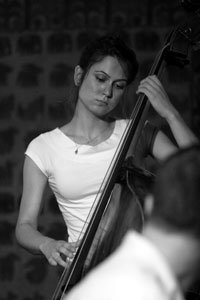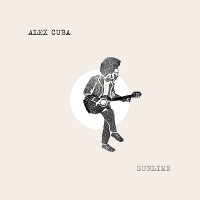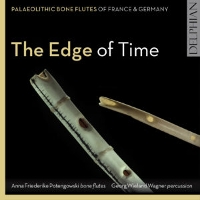Brandi Shows Another Side: The 3rd Brandi Disterheft InterviewThe 3rd Brandi Disterheft Interview Brandi Disterheft is walking in the shadows of giants with her new New York anthology. I’ve been following the career of bassist Brandi Disterheft since I first heard her on Introducing the Laila Biali Trio and have been lucky enough to catch her perform four times since then. She has taken her career into her own hands and has emerged as a strong band leader. This is a little unusual for a woman in a jazz band, let alone a bass player. But, she still finds time to go on tour with some of her friends and to that end has done plenty of travelling. Her first CD Debut still gets plenty of air play and she was part of the CBC concerts series some time ago. Like another British Columbian jazz musician, Diana Krall, she is adding vocals to her repertoire. She is also refining her composing skills and this shines through on her new CD Second Side. There are some pop leanings on it, but it is first and foremost a jazz CD and a very good one. Also, she was one of three bassists featured in the November/December issue of Canadian Musician. She had been living in Toronto but has more recently been living and studying in New York. I managed to track her down recently before she returned to New York to continue her studies. JD: Today we are talking with Brandi Disterheft who is in Toronto. She has a new CD out called Second Side. I’ll have to ask her why her only friends are pigeons, but first lets find out what she’s been up to. Hi Brandi, what have you been up to? BD: Hey Jim, well we just got off the road after playing In Montreal and now I’m in Toronto for the Women’s Blues Revue and I go back to New York on Sunday.  I felt for a long time that it seemed like I have masking tape over my mouth when I'm performing music (laughs), because I wanted to speak to the people and connect to the people more.
I felt for a long time that it seemed like I have masking tape over my mouth when I'm performing music (laughs), because I wanted to speak to the people and connect to the people more.
JD: So what are you doing in New York? Are you studying? BD: Ya, I’ve been studying with Ron Carter, the amazing Miles Davis’ bass player for about a year now. First of all we were studying on sound; producing huge sound with a minimal amount of work and now we are moving on to walking bass lines. I also have a classical teacher out there, too.  JD: That sounds like a lot of work. BD: It’s great to keep moving forward and keep me inspired and I’m always trying to get better. JD: How did you meet the great Ron Carter? BD: I have a very good friend there, Anne Drummond, who’s a flutist and I met her through the Sisters in Jazz Program through the IJAE years ago. She’s wonderful and plays with Kenny Barron and all these amazing people. She also plays a lot with a Brazilian cat, who she introduced me to called Percinio, a drummer who is quite well known in the Brazilian jazz community in New York. He has recorded and played with Ron Carter, so he introduced me to him. JD: I’m glad you’re taking advantage of that to train with someone that is so famous. Like you said, he played with Miles Davis. Wow! BD: He’s a real master. I feel so honoured, and he’s really dedicated to teaching. Some times I think to myself, “Why is he spending time with me, you know, why does he care so much?” But, I think he just wants to pass on the knowledge and the art form. He’s incredible. I wanted to study with him because I knew he really helps people with sound. I have the gut strings on. I’m a usually a hard hitter. I like the thump, thump, old school. This is definitely more modern. JD: That’s quite interesting. Now, the main reason I’m phoning is that you have a new CD out on the Justin Time label called Second Side. Is this title and obvious progression from your first CD which was called Debut or does it have other connotations? BD: Yes, it’s partially that, but also because it’s a new side that I haven’t shown before. I really found a love for lyric writing and I really fell in love with Joni Mitchell. Finally! It took me years and also the Brazilian pop sensation Milton Nascimento; the most beautiful music! So I think there are inflections (of him) on some of these songs and throughout this CD. I just wanted people to know it’s a new side; a different side, also. JD: That different side includes you stepping out from behind the jazz bass to show your vocal and even your whistling talents. Your first vocal appearance on Second Side is actually in the French language on the second track which is called “Combien de Chances.” Were you comfortable doing vocals for the first time on a CD and especially in French? BD: Ya, I love these lyrics and they have a little bit of a political message, too. Combien de chances means how many chances? How many chances do we get in life? How many chances does the rain give the sun to stop drying up its tears of joy and how many chances do we give our leaders to end wars and then I relate it at the end to love. How many chances do we get in love? This song, because of the melody was just suited to be in French and that just gave it a whole different character. So, I called my friend, Roxanne Potvin, who is one of my favourite, favourite, singer/songwriters and she helped me translate it. And, I was working with my aunt who coached me a lot. She’s a wonderful singer in LA who worked with Sergio Mendes. I was in good hands and she really helped me a lot. I felt for a long time that it seemed like I have masking tape over my mouth when I’m performing music (laughs), because I wanted to speak to the people and connect to the people more. Also all the jazz tunes that I’ve been writing have lyrics; although, I still play some of them instrumentally, so it just seemed like a natural progression. JD: Ya, it’s kind of neat. I didn’t know the translation so it’s making more sense to me now. What I found about that song (“Combien de Chances”) is that it could have been plucked from a Quentin Tarantino movie. BD: That’s what I was going for. Exactly! JD: Oh, it just has that feel about it. BD: Edgy, so the younger generation can get into it a way to draw them in and also show them jazz. Grab their attention. JD: I think that just might work. BD: And the horn line I kind of took from a great Jackie McLean intro. There’s a lot of jazz in there. JD: It’s a nice mix. I noticed you have a guitarist on five tracks. You call him “Champagne” James Robertson. I like his tone. Where did you find this guy?  We had the opportunity to perform in Haiti last January. �Everyone was singing along with us and it was so rejoiceful and it is such a beautiful night and that is what inspired "A Night in Haiti"
We had the opportunity to perform in Haiti last January. �Everyone was singing along with us and it was so rejoiceful and it is such a beautiful night and that is what inspired "A Night in Haiti"
BD: Just in the scene, around Toronto, before I left for New York. He plays in a number of bands. He’s in a band called Run with the Kittens. He also has his own band called Elvis Bossa Nova. He also has a band called the Duke Ellington Spy Band. I fell in love with his sound and that’s the sound I wanted for my music. I find the guitar, so often in jazz, the modern jazz guitar sound; I really, quite, dislike it. He has sort of a new sound, although I guess it’s an old—sort of the 60s spy sound, but I just thought it was really, really refreshing. He plays my songs beautifully and I don’t really have to tell him anything and he plays it exactly how I hear it.  JD: That’s great. I do like all the tracks that he’s on. I also sort of caught in “Second Dawn” he did a little bit of “Blinded by the Light” which was covered by Springstein, but I think Manfred Mann did it originally. There’s a part in that which just has that feel. That’s a really neat song, too and I don’t know if that song influenced him but I just got that feel from that part of “Second Dawn.” I’ll talk about some of the other tracks, too. I sort of notice a little tribute or a feeling of Dizzie Gillespie a couple of times in Second Side; “A Night in Haiti” for example, made me thinks of “A Night in Tunisia” and on “Why Are My Only Friends Pigeons.” I got that feel in that one, too. Was that intentional or is that from influences over the years. BD: Well, “A Night In Haiti”—we had the opportunity to perform in Haiti last January at the International Jazz Festival and it was an amazing experience. We had two armed guards and two escort cars with us at all times, which is embassy protocol. It is an absolutely beautiful country. We performed in the public square for everyone and we closed with the song “He’s Walking” which is off the album. Everyone was singing along with us and it was so rejoiceful and it is such a beautiful night and that is what inspired “A Night in Haiti” and part of the groove is based on “A Night in Tunisia.” So you are right on, there. You mentioned “Pigeons,” too. Ya, you know how Charlie Mingus has all those funny titles like “The Shoes of the Fisherman's Wife Are Some Jive Ass Slippers”? I just wanted to emulate that, and when I first moved to New York I didn’t really know anyone and I was mainly practicing. I had a window sill and all these pigeons were coming and so to make myself fell good I just wrote myself an uplifting bop head. JD: (Laughs) I love that title—“Why Are My Only Friends Pigeons.” You could take that to mean a lot of different things. It’s very cool. I also liked “Liege.” BD: Liege is an industrial city in Belgium. When you think about travelling to Belgium, you think about chocolate and beautiful atmosphere. Yet, it was quite and industrial town and quite populated. I thought if you just moved there you could escape the world and no one would know you existed, so there’s this haunting melody that comes from that and it just emulates that feeling and that comes from that city in Belgium. JD: I also got out of that, a little bit of the song that was co-written by Charlie Chaplin, “Smile.” It just seems to have that sound. BD: People have mentioned that to me, but I never thought about it that way and it might be in there, a bit. BD: Oh my God! JD: Eventually nothing bad happened, but young and foolish … BD: How did you almost get shot? JD: We were travelling through Ghent in winter and we didn’t have much money left and we were almost out of gas. We made to a gas station and it was late at night, and we were freezing and we wanted to wake the owner up to buy some gas and we were banging loudly on the door. He came out with a gun and was pointing it at us and there was yelling and screaming. Let’s say it was interesting. This was back in the 70s. The next day it was still the only gas station we could get to and he did sell us gas at the appropriate time. So that’s my memories of Belgium (laughs), but I like your impressions a little bit better. BD: Wow. (Laughs) Great! JD: So, how did you mange to get two of the most recognizable names in Canadian jazz on this CD in Holly Cole and Ranee Lee? Are they your buddies? BD: I went on the road to Germany for one of Holly’s ( last tours as her bass player and she is so inspiring. I grew up playing her music in talent contests; actually with Laila (Biali). You know Laila, the great piano player? We played some of her music. When I got the call to go on the road with her I was so excited. Meeting her—she’s so charismatic and she’s one of those people that you just want to be their best friend. She’s just a riot and I had such a great time with her. She knows so much about the music and putting together a show. I learned so much from her. I wrote this sort of countryesque sort of song. It has satirical lyrics, but with a happy beat—“He’s Walking.” I called Holly and I said, “Holly, I wrote this song and what do you think about singing it?” She listened to it and said she loved the song but wanted to change the bridge. So I said, “Go ahead and change the bridge.” So she sang it and I love what she does. JD: Ya, it is a lot of fun. I remember hearing it for the first time when you played in Vernon last year. You guys did it on stage and it was so much fun. Everybody was just jumping around. That’s a neat tune. BD: Oh, ya I remember that. I’ve always been a fan of Ranee Lee. I remember my Mom and me listening to her. I always respect my Mom’s opinion on who she likes and who she doesn’t like. I met Ranee for the first time in Montreal because we were both billed on the same stage and I feel in love with that tune “This Time the Dream’s on Me” because Charlie Parker does it as an instrumental. Then I found out that there were lyrics and I thought wow if I could get anyone to sing the song I’d like to get Ranee sing it. JD: There’s a million standards, why choose this one? BD: There’s this great box set Charlie Parker New York Anthology and it has these amazing live, obscure recordings and all you hear is saxophone and kick drum and it sounds like hip-hop even though it’s bebop—you know that time. I swear that’s why people were so into that music. Not because they appreciated jazz more, but just because it really, really moves people. And I found the lyrics and the last lyrics are “I’ll see you through until you are everything you want to be, but this time the dream’s on me.” You know, I just fell in love with the lyrics. JD: Ya, that is so beautiful and it was done by Harold Arlen and Johnny Mercer. BD: Yes. JD: Actually Johnny Mercer would have been 100 in November (2009)? Well Brandi, I heard a rumour about you last summer. Did you become an infamous Shuffle Demons? BD: I did. JD: Oh, I don’t know (laughs). Tell us about it. BD: It was incredible. I wanted to be in that band for so long. They are so amazing. I played with Rich Underhill in some of his jazz projects. So I got the call and I’d never played with Stitch on drums, before and it was such a blast. There are three saxophones and they are pumping out these lines and I have all control of the harmonic nature of it and you’re just pumping out funky bass lines and it was amazing. The bass player, who has been with them for a while is George Koller. When he plays with them he does what I call the bass sacrifice. He lifts the upright bass over his head playing it like an electric guitar and in one of his bass features he sings like [high pitched sounds] as he has studied Indian music. So, there were some big shoes to fill. I had a blast. JD: More importantly, what did they make you wear? BD: Actually Holly Cole and I were hanging out and we ended up painting my dress together. So I bought a dress with similar colours—the grey and black and I ended up painting it. It was Kurt Swinghammer who I’m sure painted their costumes and I called him, but I just ran out of time, so I wanted the same painting, but we did do it ourselves. JD: Do you have any photos of that up on your site? BD: I don’t. I should put one up. JD: You got to; you got to. BD: A fan e-mailed me one, so I should put that up. JD: Hope you do. That’s cool. Thanks for speaking with me. Your new CD “Second Side” went to No. 1 on the Jazz Charts at CFBX and I think it was No. 10 overall recently, so we obviously like it at “The X.” Thanks again for your time. BD: Wow! Thanks for having me. Good night. |
Reviews

Mngwa

Andrew Franey

The Shangs

Alex Cuba

Tri Nguyen

Defend The Rhino

Talltale

Kiwi Jr.

Plaster

Hyness

Black Suit Devil

Yamantaka // Sonic Titan

The Pack A.D.

Chad VanGaalen

Potengowski Anna Friederike

Todd Rundgren

Old 97's

Needles//Pins







